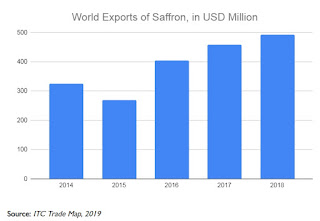North-East India to grown Kashmiri Kesar (Saffron) to make India self-reliant
Saffron cultivation in India would no longer be the monopoly of Kashmir alone. Efforts made by the Department of Science and Technology, Government of India, has started yielding results, the Saffron of Kashmir quality has started flowering in Yangyang region of Sikkim this year with the efforts of the North East Centre For Technology Application and Reach (NECTAR).
The Yangyang region of Sikkim has started its cultivation in Sikkim successfully and it would subsequently start in other regions of the North-Eastern areas. And if it really turns into a reality, It would change the future of the people in North East since it has great potential in national as well as international market.
Saffron is one of the costliest herbs in the world as costly as gold depending upon its quality. Pricewise speaking its retail price in India is as much as Gold. According to a rough estimate, it costs nearly USD 65 (Rs 4,745) for a gram of saffron. Presently India produces good quality saffron only in Kashmir and is number two in its production after Iran. Yet it is not able to meet its domestic demand. To satisfy its demand, it imported saffron to the tune of nearly USD 18.3 million in 2018.
World over its production is mostly confined to Iran where it produces more than 90 % saffron. In India its cultivation is limited to Pampore region of Jammu and Kashmir followed by Budgam, Srinagar and Kishtiwar districts. After its introduction in North-Eastern India, the production is likely to increase. From importer of Saffron, India may turn an exporter of the hurb in the coming years.
The move was initiated by the North East Centre For Technology Application and Reach (NECTAR), an autonomous body under the Department of Science and Technology (DST). It had launched the pilot project to explore the feasibility of growing saffron in North East region with the same quality and higher quantity in Yangyang area of Southern Part of the North East state.
"In the pilot project seeds were transported from Kashmir to Sikkim and acclimatized. It is now flowering in Yangyang in Southern part of the North East State,” said a senior officer of the Department of Science and Technology (DST) here on Monday.
Further, it has also planned a detailed analysis and testing of all parameters, including soil testing, quality, quantity, and possible value addition for immediate results and extrapolation of the project to other parts of the North East Region along with Micro Food Enterprises.
After its successful cultivation in Yangyang, it would be spread in other areas of North Eastern Region targeting the quality of Kashmir Kesar with high yeild in North East, the University claims
About Kashmiri Safron (कश्मीरी केसर)
Saffron is one of the world’s most distinguished and rare agricultural products cultivated as a source of spice for at least 3,500 years. The name ‘saffron’ is a derivative of the Arabic “zá-faran”, which means ‘be yellow’. Saffron is heavily demanded by consumers due to its application in the food and beverage industry, which is anticipated to be a significant factor driving the growth of the global saffron market. In food, saffron is used as a flavouring agent, spice and yellow food colouring, which makes it one of the most preferred spices for consumers.
Kashmir Saffron has been given the Geographical Indication (GI) tag by the Geographical Indication Registry. It is grown in the region of Kashmir including Pulwama, Bedgam, Kishtwar and Srinagar.
One stigma of saffron weighs about 2 mg and on an average, each flower has three stigmata, so near about 1,00,000 to 150,000 flowers are to be picked one-by-one in order to produce 1 kg of the spice. That's why Saffron is considered as one of the world’s most expensive spices. Its price in the international market is as high as Rs 5,00,000 a kg to Rs 20,00,000 a kg depending upon its aroma quality, colour and taste.
Though main cultivating countries of Saffron is Iran, it is imported by countries like Spain, France and Italy, which exports it after value-adding to the product, They have sophisticated, well-established packaging methods and distribution channels. The next step India should do is to establish such a sophisticated processing unit and market it internationally.
Saffron is currently being cultivated in Iran, India, Afghanistan, Spain, Greece Italy, Turkey, France, Switzerland, Israel, Azerbaijan, China, Egypt, UAE, Japan, Iraq and recently Australia (Tasmania). The world’s total production of dried saffron is estimated to be around 325 tonnes a year. Iran produces more than 90% of the world’s total production, India is second.
Impressive Health Benefits of Saffron
2) May Improve Mood and Treat Depressive Symptoms
3) May Have Cancer-Fighting Properties
4) May Reduce PMS (Premenstrual
syndrome) Symptoms
6) May Reduce Appetite and Aid Weight Loss
7) May reduce heart disease risk factors
8) May lower blood sugar levels
9) May improve eyesight in adults with age-related
macular degeneration (AMD)
10) May improve memory in adults with Alzheimer’s
disease







No comments:
Post a Comment